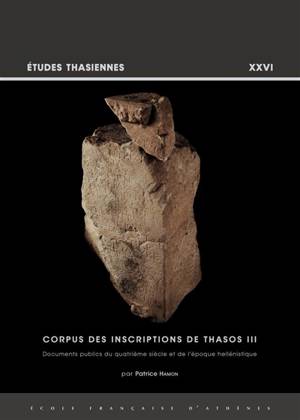
- Afhalen na 1 uur in een winkel met voorraad
- Gratis thuislevering in België vanaf € 30
- Ruim aanbod met 7 miljoen producten
- Afhalen na 1 uur in een winkel met voorraad
- Gratis thuislevering in België vanaf € 30
- Ruim aanbod met 7 miljoen producten
Documents publics du quatrième siècle et de l'époque hellénistique
Documents publics du quatrième siècle et de l'époque hellénistique
Patrice HamonOmschrijving
Les fouilles menées dans l'île de Thasos ont mis au jour près de mille cinq cents inscriptions, de toutes époques et de nature fort diverse, qui éclairent les institutions politiques, la défense, les cultes, la société et l'économie de la cité antique - l'une des mieux connues de la mer Égée. Soixante-cinq ans après les Recherches sur l'histoire et les cultes de Thasos de J. Pouilleux, le présent volume inaugure un nouveau Corpus des inscriptions de Thasos, ordonné chronologiquement et thématiquement. Ce fascicule (CITh III) réunit les inscriptions à caractère public datées entre ca 400 et 30 av. J.-C. À l'orée du IVe siècle, la cité sort d'une longue période de guerres civiles et se reconstruit, mais perd bientôt la plupart des possessions continentales qui avaient fait autrefois sa fortune. Thasos n'est désormais qu'une polis d'importance moyenne, quoique prospère, à l'échelle du monde égéen dominé par Athènes, puis par le royaume de Macédoine et enfin par les Romains. Sont ici édités ou réédités et commentés cent vingt-sept documents, gravés dans l'agora et dans les sanctuaires urbains. On trouve parmi eux des décrets réglementaires ou honorifiques, des ventes de citoyenneté, des contrats de location de domaines sacrés, des dédicaces de collèges de magistrats ou de soldats, des décrets d'associations, des décrets de cités étrangères honorant des Thasiens, etc. Prises dans leur ensemble, ces inscriptions témoignent de la vitalité de la communauté civique et de la multiplicité de ses échanges avec le monde grec, ainsi que de l'engagement politique des familles les plus en vue, souvent d'ascendance ancienne. Le volume comprend une mise au point sur la chronologie locale, une étude de la paléographie et un catalogue raisonné des quelque mille individus mentionnés dans ces documents.
The excavations carried out on the island of Thasos have brought to light almost one thousand five hundred inscriptions from all periods and of very different kinds. They throw light on the political institutions, the defence, cults, society and economy of the ancient city - one of the best known in the Aegean. Sixty-five years after the publication of J. Pouilloux's Recherches sur l'histoire et les cultes de Thasos, the present volume (CITh III) inaugurates a new Corpus des inscriptions de Thasos, organized chronologically and thematically. It contains the public inscriptions dated to between c. 400 and 30 BC. At the dawn of the fourth century the city, emerging from a long period of civil wars, began to rebuild itself, but it soon lost most of its continental possessions, which had constituted its main source of wealth. From then on, Thasos, even if prosperous, was a city of only average importance in the wider context of an Aegean dominated by Athens, then by the kingdom of Macedonia and finally by the Romans. In this volume, one hundred and twenty-seven inscriptions from the agora and from the city's sanctuaries are published or newly edited and commented on. Among them can be found regulatory and honorific decrees, sales of citizenship, rental contracts of sacred land, dedications made by bodies of magistrates or soldiers, decrees of associations, decrees from foreign cities honouring Thasians, etc. Taken together, these inscriptions testify to the vitality of the civic community and to the multiplicity of its exchanges with the rest of the Greek world, as well as to the political engagement of its most conspicuous families, often going back over generations. The volume contains a revision of the local chronology, a study of the paleography of the inscriptions and an annotated index of one thousand or so individuals mentioned in these documents.
Specificaties
Betrokkenen
- Auteur(s):
- Uitgeverij:
Inhoud
- Aantal bladzijden:
- 550
- Taal:
- Frans
- Reeks:
- Reeksnummer:
- nr. 3
Eigenschappen
- Productcode (EAN):
- 9782869583054
- Verschijningsdatum:
- 15/02/2020
- Uitvoering:
- Paperback
- Formaat:
- Trade paperback (VS)
- Afmetingen:
- 210 mm x 300 mm
- Gewicht:
- 2040 g

Alleen bij Standaard Boekhandel
Beoordelingen
We publiceren alleen reviews die voldoen aan de voorwaarden voor reviews. Bekijk onze voorwaarden voor reviews.











